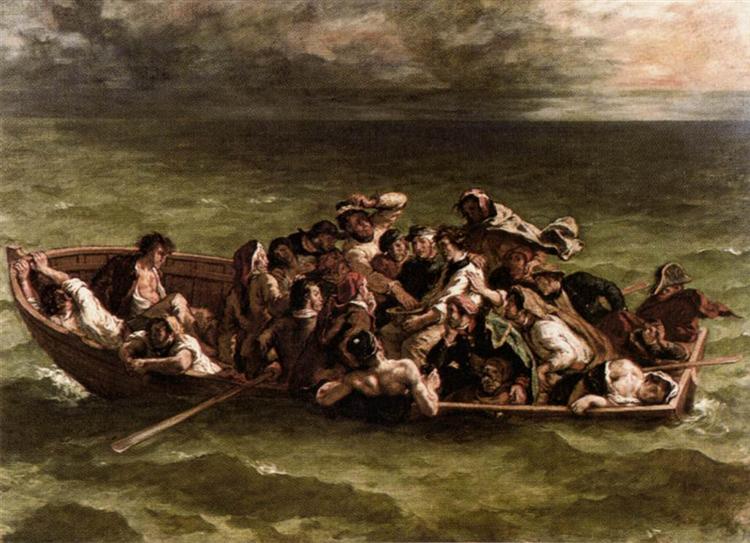Description
The painting "The Shipwreck of Don Juan", painted by Eugène Delacroix in 1840, is a masterful representation of Romanticism, a movement that sought to evoke intense emotions and a sense of the sublime, often through the struggle between the individual and natural forces. This particular painting is inspired by the character of Don Juan, a literary figure who appears in various works of European literature as a symbol of seduction, defiance of authority, and, in the context of this shipwreck, the impermanence of life.
The composition of the work is dynamic and full of movement. Delacroix uses a visual organization that draws the eye to the center, where Don Juan's body is found, caught up in the desperate struggle to survive. The tension is palpable, with the agitated waves and the cloudy sky, creating an atmosphere of chaos and desolation that accentuates the tragedy of the shipwreck. The characters are presented in a visceral struggle; they are not easily identifiable figures, but rather symbolize the human conflict against nature. This representation prevents an easy reading of their identities, focusing on the event and the raw emotion it evokes.
The use of colour is another fascinating aspect of the painting. Delacroix makes use of a vibrant palette, which oscillates between dark and dramatic tones, such as the greys and blues of the rough sea, and brighter touches that highlight the figure of Don Juan and other castaways. This contrast not only directs the viewer's attention to the central drama, but also highlights the emotional state of the characters: despair and the struggle for breath amidst a hostile environment. Moreover, light seems to filter in from the top, suggesting a ray of hope, even though fate seems bleak.
As one of the leading exponents of Romanticism, Eugène Delacroix was often drawn to literary and mythological subjects. In The Shipwreck of Don Juan, he manages to capture the spirit of a tragic narrative through a style that combines vivid detail with raw emotion. The artist's ability to render movement and energy in the waves and human figures is a testament to his technical mastery. The work invites the viewer to be drawn in and empathize with the castaways' plight, reflecting a deep understanding of the human condition.
The painting, though less well-known than other Delacroix masterpieces such as Liberty Leading the People, shares his dramatic and emotional essence. His ability to evoke personal struggle and beauty amidst tragedy is a hallmark of Romanticism, and this work is no exception. The depiction of this tragic fate emphasizes the vulnerability of human beings to forces beyond their control, a theme that resonates lightly in the hearts of all who view the work.
"The Shipwreck of Don Juan" can be seen as an example of how Delacroix enriches narrative through striking visual representation. The work is more than just an aesthetic staging; it is a dialogue between man and nature, a reminder of the forces beyond us, and a display of the transformative power of art itself. Through this piece, Delacroix not only pays homage to Don Juan's laterality, but also invites reflection on the universal struggle for survival and the meaning of our existence in an unpredictable world.
KUADROS ©, a famous painting on your wall.
Hand-made oil painting reproductions, with the quality of professional artists and the distinctive seal of KUADROS ©.
Painting reproduction service with satisfaction guarantee. If you are not completely satisfied with the replica of your painting, we will refund 100% of your money.

